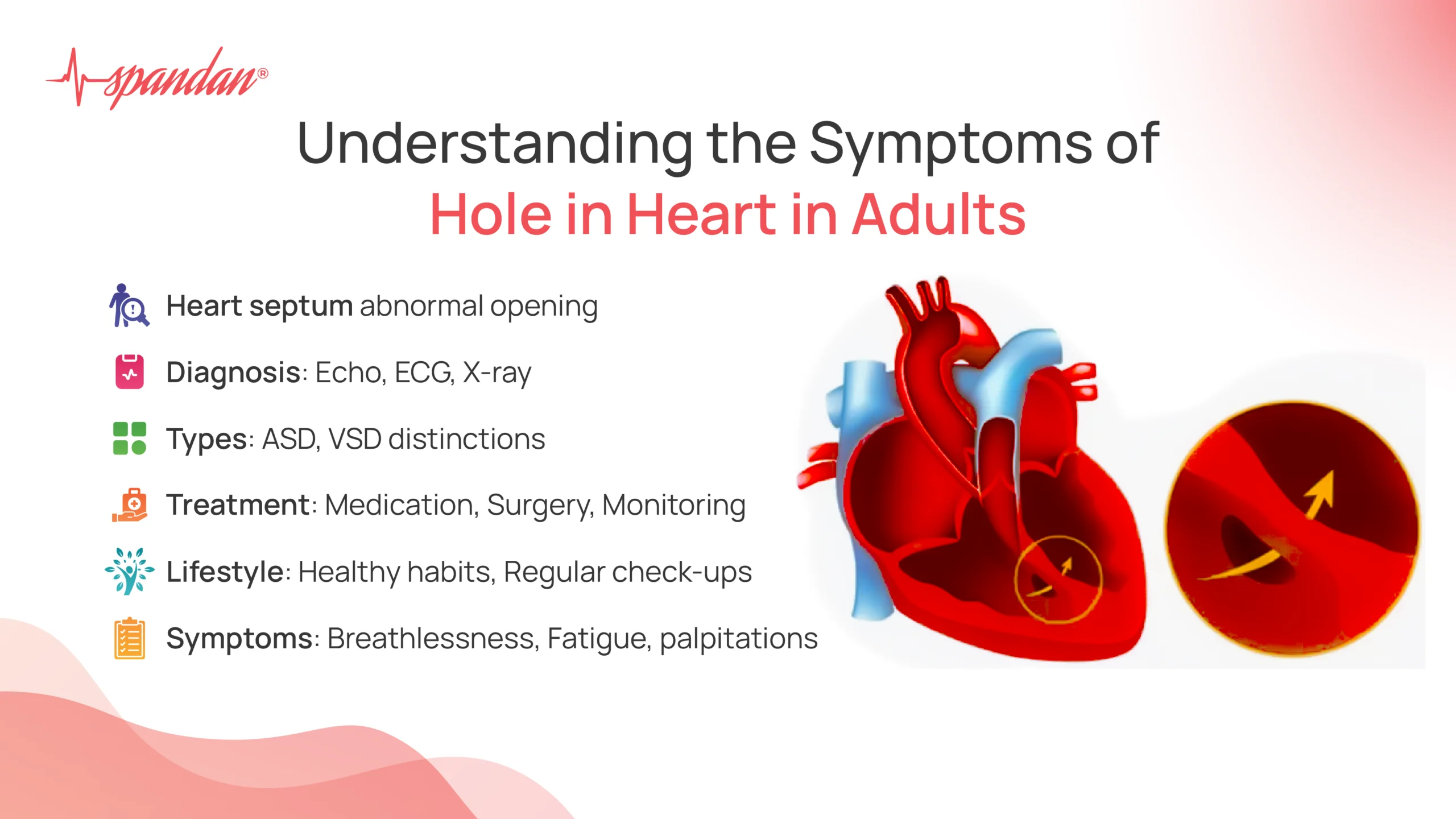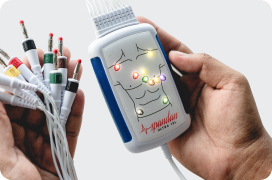
Related Article
Author:- Mr. Ritesh Sharma
A hole in the heart is a common term used to describe a congenital heart defect where there is an abnormal opening in the heart’s septum. This septum divides the heart’s chambers and prevents the mixing of oxygenated and deoxygenated blood. While holes in the heart are often diagnosed and treated during childhood, they can persist or even manifest later in life. Understanding the symptoms of hole in heart in adults is crucial for timely diagnosis and appropriate treatment.
Types of Heart Holes
Before delving into the symptoms of hole in heart in adults, it’s important to understand the two main types of septal defects that can affect adults:
- Atrial Septal Defect (ASD): This is a hole in the wall (septum) that separates the upper chambers of the heart (atria). ASDs can vary in size and can sometimes go unnoticed until adulthood.
- Ventricular Septal Defect (VSD): This is a hole in the wall that separates the lower chambers of the heart (ventricles). VSDs are usually detected in infancy, but smaller defects can be overlooked and cause symptoms later in life.
Why Holes in the Heart Matter
The presence of a hole in the heart can lead to abnormal blood flow patterns, which can strain the heart and lungs, leading to various symptoms and complications. Recognizing the symptoms of hole in heart in adults is essential for preventing long-term damage and improving quality of life.
Common Symptoms of Hole in Heart in Adults
Adults with a hole in the heart may experience a range of symptoms that can affect their daily lives. Here are some of the most common symptoms of hole in heart in adults:
- Shortness of Breath: One of the most frequent symptoms of hole in heart in adults is shortness of breath, particularly during physical activity. This occurs because the abnormal blood flow increases the workload on the heart and lungs.
- Fatigue: Adults with a hole in the heart often feel unusually tired or weak, even with minimal exertion. This is due to the heart’s reduced efficiency in pumping oxygenated blood throughout the body.
- Heart Palpitations: Irregular heartbeats or heart palpitations are common symptoms of hole in heart in adults. These can be felt as fluttering or pounding sensations in the chest.
- Swelling (Edema): Fluid buildup in the legs, ankles, or abdomen can occur due to the heart’s compromised ability to pump blood effectively. This swelling is a key indicator of heart problems.
- Frequent Respiratory Infections: Adults with a hole in the heart are more prone to respiratory infections such as bronchitis or pneumonia. This is because the abnormal blood flow can cause congestion in the lungs.
- Cyanosis: Although more common in cyanotic heart defects, a significant hole in the heart can sometimes lead to a bluish tint to the skin, lips, or fingernails due to low oxygen levels in the blood.
- Stroke: In some cases, a hole in the heart can increase the risk of stroke. This happens when a blood clot that forms in another part of the body passes through the hole and reaches the brain.
Less Common Symptoms
In addition to the more prevalent symptoms of hole in heart in adults, there are less common symptoms that some individuals may experience:
- Dizziness or Lightheadedness: Feeling dizzy or lightheaded can occur due to inadequate blood flow to the brain.
- Chest Pain: Some adults with a hole in the heart may experience chest pain, especially during physical exertion.
Diagnosing Hole in the Heart in Adults
Recognizing the symptoms of hole in heart in adults is the first step towards diagnosis and treatment. If you suspect you might have a heart defect, it’s important to seek medical attention. Here are the common diagnostic methods:
- Physical Examination: A healthcare provider will listen to your heart with a stethoscope to detect abnormal sounds, such as heart murmurs, which can indicate a hole in the heart.
- Echocardiogram: This ultrasound test provides detailed images of the heart’s structure and function, allowing doctors to see any holes in the septum.
- Electrocardiogram (ECG or EKG): This test records the electrical activity of the heart and can help identify irregular heart rhythms or other abnormalities.
- Chest X-ray: An X-ray can show the size and shape of the heart and detect any fluid buildup in the lungs.
- Cardiac MRI: This imaging test provides detailed pictures of the heart and can help assess the size and location of the hole.
- Cardiac Catheterization: In some cases, a thin tube is inserted into a blood vessel and guided to the heart to measure pressure and oxygen levels in the chambers of the heart.
Treatment Options for Hole in Heart in Adults
Once diagnosed, the treatment for a hole in the heart depends on the type, size, and severity of the defect, as well as th e presence of symptoms and complications. Here are some common treatment options:
- Monitoring: Small holes that don’t cause significant symptoms or complications may only require regular monitoring by a cardiologist.
- Medications: Certain medications can help manage symptoms and prevent complications. These might include drugs to control heart rate, prevent blood clots, or reduce fluid buildup.
- Catheter-Based Procedures: Minimally invasive procedures, such as device closure, can be used to close the hole without open-heart surgery. A device is inserted through a catheter and placed to seal the hole.
- Surgery: In more severe cases, open-heart surgery may be necessary to repair the hole. This is usually recommended when the defect causes significant symptoms or complications.
Living with a Hole in the Heart
Living with a hole in the heart requires ongoing medical care and lifestyle adjustments. Here are some tips for managing the condition:
- Regular Check-ups: Regular visits to a cardiologist are essential to monitor heart function and detect any changes early.
- Healthy Lifestyle: Maintaining a Heart healthy diet, engaging in regular physical activity, and avoiding smoking and excessive alcohol consumption can improve heart health.
- Medication Adherence: Taking prescribed medications as directed can help manage symptoms and prevent complications.
- Education and Support: Learning about the condition and connecting with support groups can help manage the emotional and psychological aspects of living with a heart defect.
In conclusion, understanding the symptoms of hole in heart in adults is crucial for timely diagnosis and effective treatment. Recognizing signs such as shortness of breath, fatigue, heart palpitations, and swelling can prompt individuals to seek medical attention and receive appropriate care. With advances in medical technology and treatment options, individuals with a hole in the heart can lead healthy and fulfilling lives. If you or a loved one are experiencing symptoms of a heart defect, consult a healthcare professional for a thorough evaluation and personalized treatment plan.




